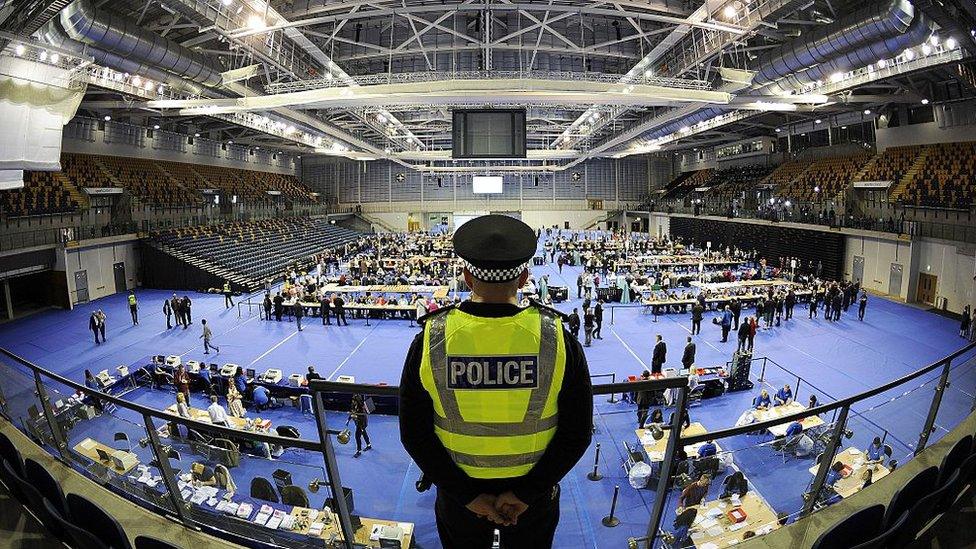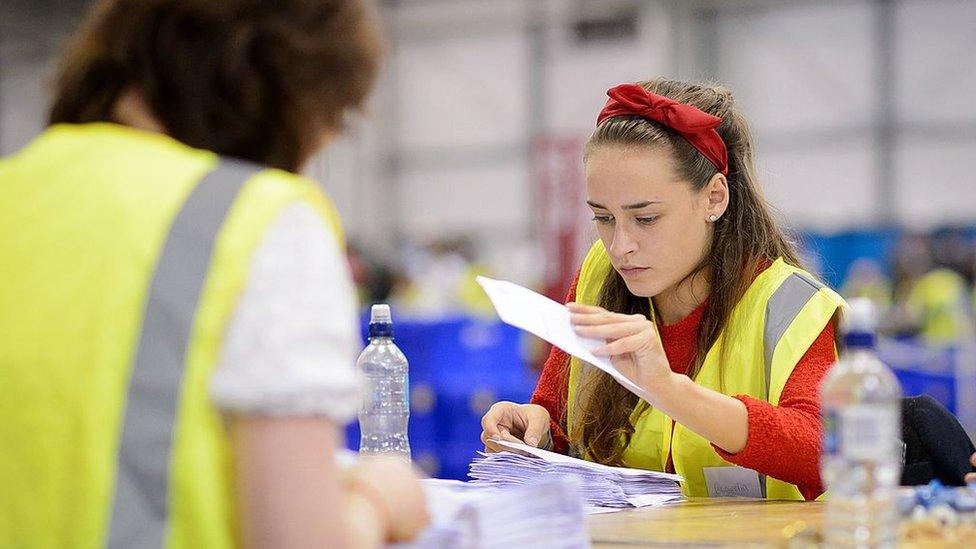Scottish election results 2021: When will we know the results?
- Published

As always, one of the biggest counts will be at the Emirates Arena in Glasgow - but it will be staggered over two days
Scots have cast their ballots in the Holyrood election, but don't need to stay up all night as Covid-19 restrictions have put paid to the usual overnight count. With votes to be tallied across Friday and Saturday, when will you know the result in your local area - and when will the overall winners be declared?

Friday, 7 May
Counting will kick off from 09:00 on Friday morning, with the Electoral Management Board projecting 48 of the 73 constituencies to be tallied that day.
The full lists can be found here, or you can look up your local results here:
Friday's constituencies include both the most marginal and safest seats from 2016, and eight of the SNP's top 10 target seats.
These include the Labour defences of Dumbarton, Edinburgh Southern and East Lothian, none of which have a majority exceeding 3%, and the Conservative seats in Ayr, Edinburgh Central, Dumfriesshire and Eastwood.
If the SNP manage to pick off the lion's share of these seats, they will feel good about going into Saturday and winning a majority.

As always, one of the biggest counts will be at the Emirates Arena in Glasgow - but it will be staggered over two days
This will particularly be the case if they can gain ground without suffering defeats in any of their own more marginal seats - Angus North & Mearns, Moray and Perthshire North are those with single-digit majorities.
The reverse is also true of course - if the SNP struggle to gain many of these marginal seats or lose some of their own, the path to a majority narrows.
By the end of Friday, it should be fairly clear which way the wind is blowing - but there will still be plenty to play for on Saturday.
Saturday, 8 May
If all goes well on Friday, the remaining 25 constituencies will count on Saturday - with the most marginal contests being between the SNP and Conservatives.
The most marginal constituencies to count on Saturday are again SNP-Tory contests, with the SNP hoping to pick off Aberdeenshire West and Galloway&West Dumfries, both with majorities under 5%.

It is not yet clear how Covid-safe protocols will affect the speed of counting
There are a few chances for the Tories to fight back too, with the SNP defences of Perthshire South& Kinross-shire, Edinburgh Pentlands and Aberdeen South and North Kincardine all having single-digit majorities.
Once each region has declared all of its constituencies, we will also start to get results from the regional lists - which could be pivotal for the overall result, as well as questions over who claims second place and the fate of smaller parties.
How does Holyrood's electoral system work?
Before we turn to the regional results, a quick note on how they are worked out.
Scotland is divided into eight electoral regions, with the 73 constituency seats scattered across them. Each region elects an extra seven MSPs from lists submitted by the parties - voted for via the peach ballot paper - giving a total of 129.
Election 2021: How does Scotland's voting system work?
The idea of the list system is to make the outcome of the election more proportional.
Once the constituency results have been declared, you divide the number of list votes each party has won by the number of seats they have already won in that region, plus one. So if a party has won nine seats in an area already, their list vote tally is divided by 10 - making it 10 times harder for them to win a seat from the lists.
There has been particular focus on the list system in 2021 thanks to the emergence of some list-only parties which encourage tactical voting, leading to a debate over whether this is "gaming the system" or simply testing the limits of the rules.
Regional list results
Timings for the counts remain very much up in the air, given we don't yet know how difficult it will prove to stack up ballots in line with Covid-19 restrictions.
But under current plans, with the exception of the big centres of Glasgow and Edinburgh, most of the count centres only have one constituency to finish off on the Saturday.
This means they could well finish up quickly - and indeed simultaneously, if there are similar numbers of ballots to count in each constituency.
Which regions will declare first?
It is hard to say, but the Highlands and Islands - normally one of the last regions to come back in an overnight count due to the vast and varied geography of the area - only has one seat to count on Saturday.
Similarly there will only be one seat left to count from the West Scotland region - so it is possible these two will be able to declare their full regional lists first.
Other regions have at least a couple of constituencies still to polish off before they can run the equations and calculate list seats. Mid Scotland and Fife could be next in line with three seats to count, all at separate locations.
However, this is largely guesswork, and a lot will depend on how the Covid-safe procedures play out at count centres. There will be four constituencies counting at the Emirates Area in Glasgow on Saturday, and three at Ingliston for the Lothian region.
South Scotland also has four counts still to run on Saturday, as does North East Scotland - with two of the latter at P&J Live in Aberdeen, which may delay matters from a logistical standpoint.
